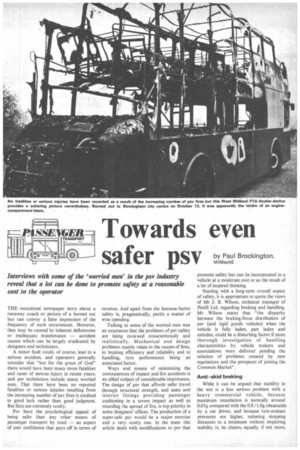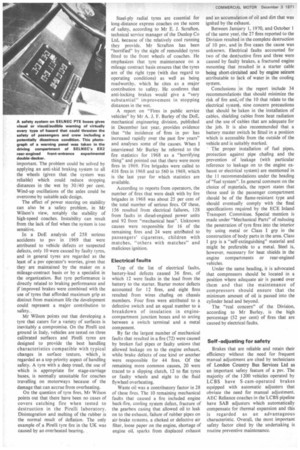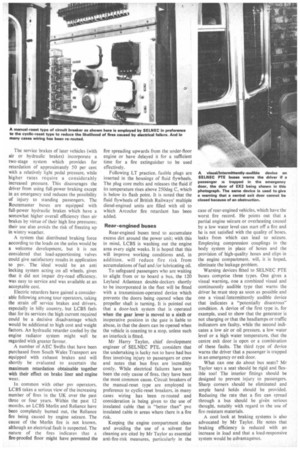Towards even safer psv
Page 49

Page 50

Page 51

If you've noticed an error in this article please click here to report it so we can fix it.
by Paul Brockington, MIMechE THE occasional newspaper story about a runaway coach or picture of a burned out bus can convey a false impression of the frequency of such occurrences. However, they may be caused by inherent deficiencies or inadequate maintenance — accident causes which can be largely eradicated by designers and technicians.
A minor fault could, of course, lead to a serious accident, and operators generally consider that "but for the grace of God" there would have been many more fatalities and cases of serious injury in recent years; and psv technicians include many worried men. That there have been no reported fatalities or serious injuries resulting from the increasing number of psv fires is credited to good luck rather than good judgment. But fires are extremely costly.
Psv have the psychological appeal of being safer than any other means of passenger transport by road — an aspect of user confidence that pays off in terms of revenue. And apart from the humane factor safety is, pragmatically, partly a matter of wise spending.
Talking to some of the worried men was an assurance that the problems of psv safety are being reviewed conscientiously and realistically. Mechanical and design problems mainly relate to the causes of fires, to braking efficiency and reliability and to handling, tyre performance being an associated factor.
Ways and means of minimizing the consequences of impact and fire accidents is an allied subject of considerable importance. The design of psv that affords safer travel through structural strength, and seats and interior fittings providing passenger cushioning in a severe impact as well as retarding the spread of fire, is top priority in some designers' offices. The production of a super-safe psv would be a major exercise and a very costly one. In the main this article deals with modifications to psv that promote safety but can be incorporated in a vehicle at a moderate cost or as the result of a lot of inspired thinking.
Starting with a long-term overall aspect of safety, it is appropriate to quote the views of Mr J. B. Wilson, technical manager of Pirelli Ltd, regarding braking and handling. Mr Wilson states that "the disparity between the braking-force distribution of' psv (and rigid goods vehicles) when the vehicle is fully laden, part laden and unladen, could be a disturbing factor if more thorough investigation of handling characteristics by vehicle makers and associations were deferred pending the solution of problems created by new regulations and the prospects of joining the Common Market".
Anti-skid braking
While it can be argued that stability in the wet is a less serious problem with a heavy commercial vehicle, because maximum retardation is normally around 0.65g compared with the 0.8 /1.0g obtainable by a car driver, and because tyre-contact pressures are higher, reducing stopping distances to a minimum without impairing stability is, he claims, equally, if not more, important. The problem could be solved by applying an anti-skid braking system to all the wheels (given that the system was reliable) which could reduce stopping distances in the wet by 30/40 per cent. Wind-up oscillations of the axles could be overcome by suitable axle design.
The effect of power steering on stability can also be a safety problem. in Mr Wilson's view, notably the stability of high-speed coaches. Instability can result from the lack of feel when the system is too sensitive.
In a DoE analysis of 258 serious accidents to psv in 1969 that were attributed to vehicle defects or suspected defects, only 10 were caused by faulty tyres, and in general tyres are regarded as the least of a psv operator's worries, given that they are maintained by the maker on a mileage-contract basis or by a specialist in the organization. But tyre performance is directly related to braking performance and if improved brakes were combined with the use of tyres that afforded maximum grip as distinct from maximum life the development could represent a major contribution to safety., Mr Wilson points out that developing a tyre that caters for a variety of surfaces is inevitably a compromise. On the Pirelli test ground in Italy, vehicles are tested on three calibrated surfaces and Pirelli tyres are designed to provide the best handling characteristics compatible with typical changes in surface texture, which , is regarded as a top-priority aspect of handling safety. A tyre with a deep tread, the use of which is appropriate for stage-carriage buses, is normally unsuitable for coaches travelling on motorways because of the damage that can accrue from overheating.
On the question of tyre fires, Mr Wilson points out that there have been no cases of covers catching fire when tested to destruction in the Pirelli laboratory. Disintegration and melting of the rubber is the normal result of deflation. The only example of a Pirelli tyre fire in the UK was caused by an overheated bearing. Steel-ply radial tyres are essential for long-distance express coaches on the score of safety, according to Mr E. J. Scrafton, technical service manager of the Dunlop Co Ltd, because of the relatively cool running they provide. Mr Scrafton has been "horrified" by the sight of remoulded tyres fitted to the front wheels of coaches. He emphasizes that tyre maintenance on a mileage contract basis ensures that the tyres are of the right type (with due regard to operating conditions) as well as being roadworthy, which he cites as a major contribution to safety. He confirms that anti-locking brakes would give a "very substantial" improvement in stopping distances in the wet.
A report on "Fires in public service vehicles" by Mr A. J. F. Burley of the DoE, mechanical engineering division, published in December last year, provides evidence that "the incidence of fires in psv has increased rapidly over the past few years" and analyses some of the causes. When I intervieWed Mr Burley he referred to the fire statistics for 1968 as a "horrifying thing" and pointed out that there were more fires in 1969. Fire brigades were called to 416 fires in 1968 and to 560 in 1969, which is the last year for which statistics are available.
According to reports from operators, the number of fires that were dealt with by fire brigades in 1968 was about 25 per cent of the total number of serious fires. Of these, 156 resulted from electrical failures, 128 from faults in diesel-engined power units and 92 from "mechanical heat". Unknown causes were responsible for 16 of the remaining fires and 24 were attributed to passengers' cigarettes, children with matches, "others with matches" and malicious ignition.
Electrical faults
Top of the list of electrical faults, battery-lead defects caused 36 fires, of which 12 were faults in the lead from the battery to the starter. Starter motor defects accounted for 12 fires, and eight fires resulted from wires chafing on chassis members. Four fires were attributed to a defective switch and an equal number to a breakdown of insulation in enginecompartment junction boxes and to arcing between a switch terminal and a metal component.
By far the largest number of mechanical faults that resulted in a fire (72) were caused by broken fuel pipes or faulty unions that allowed leakage on to the engine exhaust, while brake defects of one kind or another were responsible for 44 fires. Of the remaining more common causes, 20 were traced to a slipping clutch, 12 to flat tyres or faulty wheels and eight to the fluid flywheel overheating.
Waste oil was a contributory factor in 28 of these fires. The 10 remaining mechanical faults that caused a fire included engine back-fire, cooling system defect, fracture of the gearbox casing that allowed oil to leak on to the exhaust, failure of rubber pipes on air-brake systems. a choked or defective air filter, loose paper on the engine, shortage of engine oil, sparks from displaced exhaust and an accumulation of oil and dirt that was ignited by the exhaust.
Between January 1, 1970, and October 1 of the same yea, the 27 fires reported to the Division resulte in the complete destruction of 10 psv, and in five cases the cause was unknown. Elec rical faults accounted for two of the dest uctive fires and three were
caused by fault brakes, a fractured engine mounting that resulted in a starter cable being short-circiited and by engine seizure attributable to 1 Ck of water in the cooling system.
Conclusions in the report include 14 recommendatio s that should minimize the risk of fire and, of the 10 that relate to the electrical syste , nine concern precautions that should be aken in the installation of cables, shielding cables from heat radiation and the use of cables that are adequate for the job. It is also recommended that a battery master switch be fitted in a position which is accessible from the outside of the vehicle and is suitably marked.
• The proper installation of fuel pipes, protection against pipe chafing and the prevention of leakage (with particular reference to leakage on to the engine exhaust or electrical system) are mentioned in the 11 recommendations under the heading of "fuel system". In general comment on the choice of materials, the report states that those used in the passenger compartment should be of the flame-resistant type and should eventually comply with the final specifications required by the ECE Inland Transport Committee. Special mention is made under "Mechanical Parts" of reducing the penetration of tyre fires into the interior by using metal or Class I grp in the construction of body parts in the area. Class I grp is a "self-extinguishing" material and might be preferable to a metal. Steel is, however, necessary for heat shields in the engine compartments or rear-engined vehicles.
Under the same heading, it is advocated that compressors should be located in a position where adequate air is passed over them and that the maintenance of compressors should ensure that the minimum amount of oil is passed into the cylinder head and beyond.
The "real concern" of the Division, according to Mr Burley, is the high percentage (52 per cent) of fires that are caused by electrical faults.
Self -adjusting for safety
Brakes that are reliable and retain their efficiency without the need for frequent manual adjustment are cited by technicians of London Country Bus Services Ltd as an important safety feature of a psv. The majority of the 1200 vehicles operated by LCBS have S-cam-operated brakes equipped with automatic adjusters that obviate the need for manual adjustment. AEC Reliance coaches in the'LCBS pipeline have SAB adjusters which automatically compensate for thermal expansion and this is regarded as an advantageous characteristic. Overall, the most important safety factor cited by the undertaking is routine preventive maintenance. The service brakes of later vehicles (with air or hydraulic brakes) incorporate a two-stage system which provides for retardation of approximately 50 per cent with a relatively light pedal pressure. while higher rates require a considerably increased pressure. This discourages the driver from using full-power braking except in an emergency and reduces the possibility of injury to standing passengers. The Routemaster buses are equipped with full-power hydraulic brakes which have a somewhat higher overall efficiency than air brakes by virtue of their high line pressures; their use also avoids the risk of freezing up in wintry weather.
A system that distributed braking force according to the loads on the axles would be a welcome development, but it is not considered that load-apportioning valves could give satisfactory results in application to psv. The ideal would be an anti locking system acting on all wheels, given that it did not impair dry-road efficiency. was easy to service and was available at an acceptable cost.
Electric retarders have gained a considerable following among tour operators, taking the strain off service brakes and drivers, especially in hilly country, but LCBS feels that for its services the high current required could be a decisive disadvantage which would be additional to high cost and weight factors. An hydraulic retarder cooled by the engine radiator system might well be regarded with greater favour.
A number of AEC Swifts that have been purchased from South Wales Transport are equipped with exhaust brakes and will shortly be evaluated to ascertain the maximum retardation obtainable together with their effect on brake liner and engine wear.
In common with other psv operators. LCBS takes a serious view of the increasing number of fires in the UK over the past three or four years. Within the past 12 months. an LCBS Merlin and Reliance have been completely burned out, the Reliance fire being caused by engine seizure. The cause of the Merlin fire is not known. although an electrical fault is suspected. The nature of the fires indicates that a fire-proofed floor might have prevented the fire spreading upwards from the under-floor engine or have delayed it for a sufficient time for a fire extinguisher to be used effectively.
Following LT practice. fusible plugs are inserted in the housings of fluid flywheels. The plug core melts and releases the fluid if its temperature rises above 250deg C, which is below its flash point. It is noted that the fluid flywheels of British Railways' multiple diesel-engined units are filled with oil to which Arcoclor fire retardant has been added.
Rear—engined buses
Rear-engined buses tend to accumulate excess dirt around the power unit; with this in mind, LCBS is washing out the engine area every eight weeks. It is hoped that this will improve working conditions and, in addition. will reduce fire risk from accumulations of fuel and /or lubricating oil.
To safeguard passengers who are waiting to alight from or to board a bus. the 120 Leyland Atlantean double-deckers shortly to be incorporated in the fleet will be fitted with a transmission-operated device which prevents the doors being opened when the propeller shaft is turning. It is pointed out that a door-lock system that is operated when the gear lever is moved to a sixth or inoperative position in the gate is liable to abuse, in that the doors can be opened when the vehicle is coasting to a stop. unless such an interlock is fitted.
Mr Harry Taylor, chief development engineer of SELNEC PTE, considers that the undertaking is lucky not to have had bus fires involving injury to passengers or crew and notes that bus fires are incredibly costly. While electrical failures have not been the only cause of fires, they have been the most common cause. Circuit breakers of the manual-reset type are employed in preference to cyclic-reset breakers, in many cases wiring has been re-routed and consideration is being given to the use of insulated cable that is "better than" pvc insulated cable in areas where there is a fire risk.
Keeping the engine compartment clean and avoiding the use of a solvent for cleaning are cited by Mr Taylor as essential anti-fire-risk measures, particularly in the case of rear-engined vehicles, which have the worst fire record. He points out that a partial engine seizure or overheating caused by a low water level can start off a fire and he is not satisfied with the quality of hoses, leaks from which can lead to seizure. Employing compression couplings in the body system in place of hoses and the provision of high-quality hoses and clips in the engine compartment. will, it is hoped. eliminate the leakage problem.
Warning devices fitted to SELNEC PTE buses comprise three types. One gives a visual warning, one a combined visual and continuously audible type that warns the driver he must stop as soon as possible and one a visual /intermittently audible device that indicates a "potentially disastrous" condition. A device of the first type is. for example, used to show that the generator is not charging or that the headlamps or traffic indicators are faulty. while the second indicates a low air or oil pressure. a low water level or a high water temperature, that the centre exit door is open or a combination of these faults. The third type of device warns the driver that a passenger is trapped in an emergency or exit door.
What can one do about bus seats? Mr Taylor says a seat .should be rigid and flexible too! The interior fittings should be designed to prevent injury to passengers. Sharp corners should be eliminated and ample hand holds should be provided. Reducing the rate that a fire can spread through a bus should be given serious thought. notably with regard to the use of fire-resistant materials.
A cool look at braking systems is also advocated by Mr Taylor. He notes that braking efficiency is reduced with an increase in load and that a load-responsive system would be advantageous.


































































































































